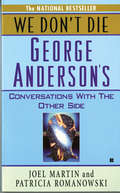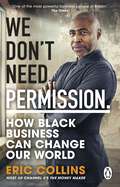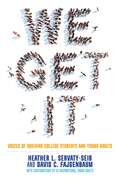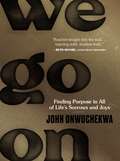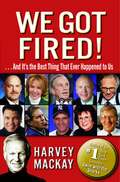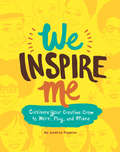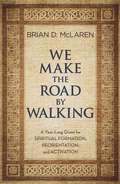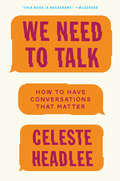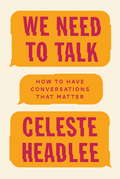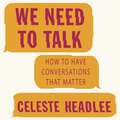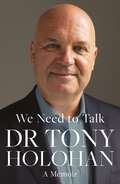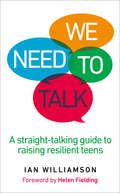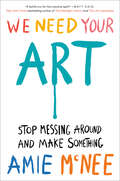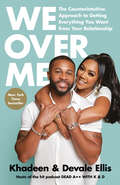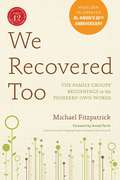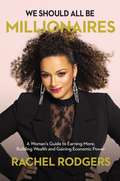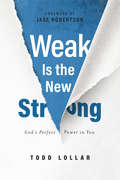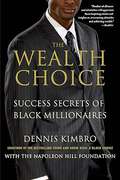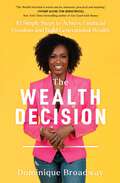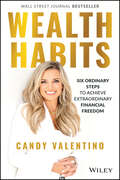- Table View
- List View
We Don't Die
by Patricia Romanowski Joel MartinThis is a book that will open your mind to an infinite realm of possibility, reassurance, and spiritual growth. It is the phenomenal true story of George Anderson. A man gifted with the extraordinary ability to communicate with spirits "on the other side," Anderson offers documented evidence of his powers through thousands of readings and dozens of scientific tests. Believers and skeptics alike have been astonished by the accuracy of his psychic communications. He reveals to his subject information--about events, experiences, trivia, even nicknames--for which the only possible source is the living consciousness of the deceased. Messages of forgiveness, peace, hope, and love... Believe it. Millions of Americans have already seen the proof of Anderson's ability on nationwide television and call-in radio. Now, the warmth and wisdom of his remarkable gift offers us all a glimpse of eternity. A heartfelt, universal vision that tells us "No one you are close to ever dies..."
We Don't Need Permission: How black business can change our world
by Eric CollinsHighly Commended for the Diversity, Inclusion and Equality Award at the Business Book AwardsA powerful 10 step guide to transformative entrepreneurship for under-represented people from Eric Collins, host of the award-winning Channel 4 reality business show The Money Maker.'Eric Collins is one of the most powerful business people in Britain.' The Times__________Step 1: Embrace the unexpectedStep 2: Engage in consistent and continuous acts of disruptionStep 3: Let go of small - think bigger, think global and prepare for pitfallsStep 4: Take risks using data to mitigate the downsideStep 5: Put your money where your mouth is, make your resources matterStep 6: Leverage what you knowStep 7: Become a convener by making your mission bigger than yourselfStep 8: Invest in women to create AlphaStep 9: Sell your vision, make time-appropriate asks and don't forget to recruit alliesStep 10: Always bet on Black________________________At a time when half of Black households in the UK live in persistent poverty - over twice as many as their white counterparts - We Don't Need Permission argues that investing in Black and under-represented entrepreneurs in order to create successful businesses is the surest, fastest socio-economic game-changer there is.Long-lasting economic empowerment - from education to health outcomes - is key to solving the multiple problems that result from systemic racism and sexism. And it is the best way to close the inequality gaps that have hampered and continue to hinder Black people and all women too. To address this problem head on, Eric Collins co-founded venture capital firm Impact X Capital to invest in under-represented entrepreneurs in the UK and Europe.In We Don't Need Permission, Collins identifies ten key principles of successful entrepreneurship, and reveals how it's possible to change a system that has helped some, while holding others back. The book not only aims to inspire and motivate under-represented people to take their future and economic destiny into their own hands, but will demand of current business leaders and organizations that they do business better.It's time to stop waiting for someone else to give permission and start boldly making the world we want to see.__________
We Gave Away a Fortune
by Christopher Mogil Anne Slepian Peter WoodrowStories of People Who Have Devoted Themselves and Their Wealth To Peace, Justice and a Healthy Environment
We Get It: Voices of Grieving College Students and Young Adults
by David C. Fajgenbaum Heather L. Servaty-SeibA unique collection of 33 narratives by bereaved students and young adults, this books aims to help young adults who are grieving and provide guidance for those who seek to support them. Grieving the death of a loved one is difficult at any age, but it can be particularly difficult during college and young adulthood. From developing a sense of identity to living away from family and adjusting to life on and off campus, college students and young adults face a unique set of issues. These issues often make it difficult for young adults to talk about their loss, leading to a sense of isolation, different-ness and a pressure to pretend that everything is OK. The narratives included in this book are honest, engaging and heartfelt, and they help other students and young people know that they are not alone and that there are others who 'get' what they are going through. The narratives are usefully divided by themes, such as isolation, forced maturity and life transition challenges, and include commentary by the authors on grief responses and coping strategies. Each section also ends with helpful questions for reflection. Inspired by the experiences of Dr. Fajgenbaum losing his mother during college and Dr. Servaty-Seib dedicating her career to college student bereavement, this book will be a lifeline for students and young adults who have lost a loved one. It will also be of immeasurable value to counselors, college administrators, grief professionals and parents.
We Go On: Finding Purpose in All of Life’s Sorrows and Joys
by John OnwuchekwaDo you often ask the question "What is my purpose in life?" Rich with black-and-white photography, powerful stories, and life-changing reflections from the book of Ecclesiastes, We Go On, by pastor and entrepreneur John Onwuchekwa calls you to find the true answer to the question: Why am I here?In a world that encourages us to find meaning in temporary things, we long to know that who we are makes a difference after we're gone. This hope-filled exploration of this biblical book of wisdom turns our attention to what our true purpose is and how to let that purpose shape our relationships, career, and life choices. Along with biblical insights, John Onwuchekwa weaves together meaningful challenges that even from difficult beginnings, we can continue to trust God's path.In this book, you'll discover a more meaningful, fulfilling life as you explore themes such as:work, wealth, and powersexuality, social relationships, and justicereligion and familyInspiring black-and-white photography paired with a modern cover make this a perfect gift to give to men and women for holidays, graduations, birthdays, new jobs, or to anyone seeking a deeper relationship with God. We Go On will help men and women:experience deeper peace in a changing worldsee biblical imagery in a fresh waypersevere through difficult circumstancesfind new motivation for living with intentionThis unique book reminds you that deeper purpose is available as you look beyond your circumstances and find meaning in the God who never changes.
We Got Fired!: . . . And It's the Best Thing That Ever Happened to Us
by Harvey MackayNo fight left? No future? Does the handwriting on the wall say utter failure? Harvey Mackay, one of the world’s best-selling motivational and business authors tells you why it isn’t so. He reveals anecdotes and secrets from some of the best and brightest headliners in our world today. Their gripping accounts show that no one is immune to bad judgment or backstabbing. In colorful detail, these remarkable success stories reveal what the best of the best did to get back on top. Each story tells a unique tale and contains valuable lessons that are applicable to any reader who wants his or her career to flourish; indeed, this is the book that will inspire, instill hope . . . and give more than a glimpse into what makes these stalwarts strong. When Fortune magazine called Mackay “Mister Make-Things-Happen,” it was right on the money—getting this amazing group of people from various walks of life to talk openly about their abilities to bounce back shows him to be a master at getting people to divulge some of their defeats and their dreams. Hopeful, tough-minded, and filled with indispensable advice, We Got Fired! . . . And It’s the Best Thing That Ever Happened to Us will show anyone how to turn a modern bummer into a major blessing. It’s a rarity: a sure thing in our shaky times.
We Inspire Me: Cultivate Your Creative Crew to Work, Play, and Make
by Andrea PippinsThe best thing a creative person can have is a crew of friends, allies, and mentors to support them. Packed with inspiration and ideas from author-illustrator Andrea Pippins, this is a one-of-a-kind handbook for doers and makers looking to expand and nourish their creative community. Drawing on her own network of talented artists, designers, and friends, Pippins offers tips on how to: reach out to your heroes; use your art or work to empower your community; learn about a new culture and shake up your perspective; take a class, join a team, plan brunch—have fun! And she delivers her advice in style. Colorful pages feature patterns, portraits, and hand-lettered quotes alongside tips for fostering genuine connections and supportive relationships.
We Make the Road by Walking: A Year-Long Quest for Spiritual Formation, Reorientation, and Activation
by Brian D. MclarenFrom critically acclaimed author Brian McLaren comes a brilliant retelling of the biblical story and a thrilling reintroduction to Christian faith. This book offers everything you need to explore what a difference an honest, living, growing faith can make in our world today. It also puts tools in your hands to create a life-changing learning community in any home, restaurant, or other welcoming space. The fifty-two (plus a few) weekly readings can each be read aloud in 10-12 minutes, and offer a simple curriculum of insightful reflections and transformative practices. Organized around the traditional church year, these readings give an overview of the whole Bible and guide an individual or a group of friends through a year of rich study, interactive learning, and personal growth. Perfect for home churches, congregations, classes, or individual study, each reading invites you to: Cultivate an honest, intelligent understanding of the Bible and of Christian faith in 21st century Engage with discussion questions designed to challenge, stimulate, and encourageRe-imagine what it means to live joyfully and responsibly in today's world as agents of God's justice, creativity, and peace If you're seeking a fresh way to experience and practice your faith, if you're a long-term Christian seeking new vitality, or if you feel out of place in traditional church circles, this book will inspire and activate you in your spiritual journey.
We Need to Talk: How to Have Conversations That Matter
by Celeste Headlee“WE NEED TO TALK.”In this urgent and insightful book, public radio journalist Celeste Headlee shows us how to bridge what divides us--by having real conversationsBASED ON THE TED TALK WITH OVER 10 MILLION VIEWS“We Need to Talk is an important read for a conversationally-challenged, disconnected age. Headlee is a talented, honest storyteller, and her advice has helped me become a better spouse, friend, and mother.” (Jessica Lahey, author of New York Times bestseller The Gift of Failure)Today most of us communicate from behind electronic screens, and studies show that Americans feel less connected and more divided than ever before. The blame for some of this disconnect can be attributed to our political landscape, but the erosion of our conversational skills as a society lies with us as individuals. And the only way forward, says Headlee, is to start talking to each other. In We Need to Talk, she outlines the strategies that have made her a better conversationalist—and offers simple tools that can improve anyone’s communication. For example: BE THERE OR GO ELSEWHERE. Human beings are incapable of multitasking, and this is especially true of tasks that involve language. Think you can type up a few emails while on a business call, or hold a conversation with your child while texting your spouse? Think again.CHECK YOUR BIAS. The belief that your intelligence protects you from erroneous assumptions can end up making you more vulnerable to them. We all have blind spots that affect the way we view others. Check your bias before you judge someone else.HIDE YOUR PHONE. Don’t just put down your phone, put it away. New research suggests that the mere presence of a cell phone can negatively impact the quality of a conversation. Whether you’re struggling to communicate with your kid’s teacher at school, an employee at work, or the people you love the most—Headlee offers smart strategies that can help us all have conversations that matter.
We Need To Talk: How to Have Conversations That Matter
by Celeste HeadleeTake a moment to consider how many outcomes in your life may have been affected by poor communication skills. Could you have gotten a job you really wanted? Saved a relationship? What about that political conversation that got out of hand at a dinner party? How is it that we so often fail to say the right thing at the right time?In her career as an NPR host, journalist Celeste Headlee has interviewed hundreds of people from all walks of life, and if there's one thing she's learned, it's that it's hard to overestimate the power of conversation and its ability to both bridge gaps and deepen wounds. In We Need to Talk, she shares what she's learned on the job about how to have effective, meaningful, and respectful conversations in every area of our lives.Now more than ever, Headlee argues, we must begin to talk to and, more importantly, listen to one another - including those with whom we disagree. We Need to Talk gives readers ten simple tools to help facilitate better conversations, ranging from the errors we routinely make (put down the smart phone when you're face to face with someone) to the less obvious blind spots that can sabotage any conversation, including knowing when not to talk, being aware of our own bias, and avoiding putting yourself in the centre of the discussion.Whether you're gearing up for a big conversation with your boss, looking to deepen or improve your connection with a relative, or trying to express your child's needs to a teacher, We Need to Talk will arm you with the skills you need to create a productive dialogue.
We Need To Talk: How to Have Conversations That Matter
by Celeste HeadleeTake a moment to consider how many outcomes in your life may have been affected by poor communication skills. Could you have gotten a job you really wanted? Saved a relationship? What about that political conversation that got out of hand at a dinner party? How is it that we so often fail to say the right thing at the right time?In her career as an NPR host, journalist Celeste Headlee has interviewed hundreds of people from all walks of life, and if there's one thing she's learned, it's that it's hard to overestimate the power of conversation and its ability to both bridge gaps and deepen wounds. In We Need to Talk, she shares what she's learned on the job about how to have effective, meaningful, and respectful conversations in every area of our lives.Now more than ever, Headlee argues, we must begin to talk to and, more importantly, listen to one another - including those with whom we disagree. We Need to Talk gives readers ten simple tools to help facilitate better conversations, ranging from the errors we routinely make (put down the smart phone when you're face to face with someone) to the less obvious blind spots that can sabotage any conversation, including knowing when not to talk, being aware of our own bias, and avoiding putting yourself in the centre of the discussion.Whether you're gearing up for a big conversation with your boss, looking to deepen or improve your connection with a relative, or trying to express your child's needs to a teacher, We Need to Talk will arm you with the skills you need to create a productive dialogue.
We Need to Talk: A Memoir
by Tony HolohanChief Medical Officer Shares His Covid Story Follow Dr. Tony Holohan’s journey as a public figure combating the pandemic during his own period of grief. Leading Ireland through the coronavirus. 12 years as the Chief Medical Officer had never prepared Dr. Holohan for an outbreak like coronavirus pandemic. Thrust into the spotlight as the leader of frontline healthcare workers, he found himself responsible for bringing Ireland through the biggest health crisis in modern history. Now, Dr. Holohan is sharing his story. We Need to Talk is a COVID-19 book retelling the difficult truths that came with navigating a country through a traumatic global crisis. Featuring exclusive access into the decisions that impacted the rise of COVID-19 cases, discover how perseverance and empathy helped Ireland through it all to our post-pandemic world. Taking the time to cherish meaningful experiences.We Need to Talk is a medical memoir dedicated to not only Dr. Tony Holohan’s role during the pandemic, but also the life and loss of his wife, Emer. Sharing her story of battling multiple myeloma for nearly a decade, he recalls their beautiful moments together and with their family before Emer’s last days. With difficult discussions about mourning while moving forward, Dr. Holohan shares the importance of rediscovering those happy memories together after saying goodbye. Also inside: Dr. Holohan’s path to becoming Ireland’s Chief Medical Officer Leading the National Public Health Emergency Team (NPHET) Making the decision to step back to spend time with his loved ones Life after the pandemic and resignation If you liked The People’s Hospital, In Love, or Loving and Living Your Way Through Grief, then you will love We Need to Talk.
We Need to Talk: A Straight-Talking Guide to Raising Resilient Teens
by Ian Williamson'WHAT EVERY PARENT SHOULD KNOW ... If anyone is qualified to give advice on how to manage this tricky time for parents, it's Ian' - The Times‘Ian Williamson is a genius … I couldn’t recommend [this]more highly’ HELEN FIELDINGHow do you talk to your teen when their only focusis the screen in front of them?How do you help them to build a core of self-esteem ina world obsessed with appearances?In this empathetic, down to earth and eminently practical guide from oneof the UK’s leading adolescent psychoanalysts, Ian Williamsonwill help you through every possible hurdle in the teenage years.- Covering topics from behaviour and relationshipsto crime and gaming- Featuring top tips and takeaway advice- With realistic solutions that you can put into practice right awayWe Need to Talk is your new go-to-guide to navigating the often trickyadolescent years, with the endgame being what every parent wants: a healthy, happy and resilient child.
We Need Your Art: Stop Messing Around and Make Something
by Amie McNeeFrom Amie McNee, the voice behind Inspired to Write, a manifesto on the vital, human importance of creating, with guidance for all artists in all endeavors, whether they're starting their journey or seeking a fresh perspective.In We Need Your Art, Amie McNee calls artists and aspiring artists of all kinds to do the work they&’re meant to do: create. Using her own experiences as a novelist and the inspiration she&’s shared as a creative coach, Amie guides you on why we need your art and how you can make it happen—starting with a two-week reset plan to help you kick-start your creative habit. This isn&’t about writing your great novel in a month or painting a masterpiece in a flurry of inspiration. Rather, this process is about practicing small, sustainable creative steps every day over time—five hundred words of writing each day, a pencil sketch every evening—so that you avoid burnout, produce consistent, reliable content on your own terms, and begin to see yourself as an artist. With frank and empowering conversations on the many issues creatives face, including impostor syndrome, perfectionism, procrastination, and the inner critic, as well as invitations to coronate yourself and celebrate your ambition, Amie provides the framework and encouragement you need to begin to take your art seriously. Each chapter also includes journal prompts that help you apply what you have learned to your new life.We Need Your Art is a revolutionary reprogramming of everything we have been taught and told about being a creative, removing the shame and fear we may feel at dubbing ourselves artists and inviting us to create proudly, with celebration. This book is a warm hug, a pep talk, the wise teacher you always wanted, the loving parent you needed, and the fire in your belly that you need to get roaring.
We Over Me: The Counterintuitive Approach to Getting Everything You Want from Your Relationship
by Khadeen Ellis Devale EllisThe stars of the social media show The Ellises and hosts of the Webby Award-winning podcast Dead Ass with K&D share the core pillars of their relationship as millennial lovers and parents that have allowed them to thrive. &“Staying married in this day and age takes a whole different mindset, and this book gives an intimate and honest look at the inner workings of their strong union.&”—Gia Peppers, award-winning journalist and hostAfter twelve years of marriage, twenty years together, and four kids, Devale and Khadeen Ellis have been through a lot. They&’ve loved their way through a long-distance relationship, financial instability, parenthood, Khadeen&’s near-death, and their near-divorce, chronicling their day-to-day life with their boys online. After much trial and error, they hit upon one surprising, essential truth: If you&’re looking for a healthy relationship and a fulfilling life, focus on your partner&’s needs instead of your wants. Choosing service over selfishness will not only make your relationship stronger, but it will help you achieve your own goals and build a legacy together.With their trademark transparency and humor, Khadeen and Devale share the messy, behind-the-scenes work of what it takes to succeed and support one another in their search for individual purpose while growing in their marriage. They discuss family, parenting, sex and intimacy, finances, and commitment, with honest advice threaded through their stories, such as: • Stop comparing yourselves to other couples and make your own rules. • Learn how to function as a team. • Keep talking about sex. • The kids ain&’t first.The Ellises might not have all the answers, but they do know that good love takes friendship, grace, and service. Their personal and relatable truths will inspire you to be the kind of partner you want to be so you can build a supportive, enduring relationship.
We Recovered Too: The Family Groups' Beginnings in the Pioneers' Own Words
by Michael FitzpatrickWith firsthand accounts told through rare recordings of interviews and speeches, diary entries, and other documents dating from the 1940s, Michael Fitzpatrick presents the inspiring story of Al-Anon.To celebrate the 60th anniversary of Al-Anon, Hazelden proudly presents this engaging multimedia retrospective of the Fellowship that has brought the miracle of recovery to countless family members and loved ones of alcoholics and addicts. With its roots in the early days of Alcoholics Anonymous, when wives joined their husbands at the AA meetings and found refuge and understanding in one another, Al-Anon Family Groups has grown into a robust worldwide fellowship of men and women healing from the impact of addiction.Through colorful firsthand accounts told through rare recordings of interviews and speeches, diary entries, and other documents dating from the 1940s, recovery historian and beloved author Michael Fitzpatrick presents the inspiring story of Al-Anon. Discover how cofounders Anne B. and Lois W. guided the growth of these groundbreaking groups, later known as Clearing House and, ultimately, Al-Anon. Take an intimate peek into these visionaries' lives through never-before-published letters provided by Stepping Stones, the historical home of Bill W. and Lois W. Listen to recordings collected by Al-Anon pioneer Arbutus O. See how the program used by the early "Wives Groups" has evolved over time. Not only will you become a witness to Al-Anon history, you will find inspiration and insight into the core principles and practices that have made this a lifesaving program for thousands worldwide.Michael Fitzpatrick is a leading historian and speaker in the field of alcoholism, specializing in the development of the Twelve Step movement. For this book, he drew from his own audio archive, possibly the world's largest collection of recordings of the Twelve Step pioneers and their legacy over the decades. He is coauthor with William G. Borchert of 1000 Years of Sobriety: 20 People x 50 Years.
We Should All Be Millionaires: A Woman’s Guide to Earning More, Building Wealth, and Gaining Economic Power
by Rachel RodgersWhile ninety percent of the world&’s millionaires are men, only ten percent are women, making it difficult for women to wield the economic power that will create lasting equality. Rachel Rodgers, founder of Hello Seven, a company that coaches women in scaling their businesses and their lives to seven figures, says it&’s time for a change.Women deserve the economic power and equality that comes with wealth, and we all have it in us to be millionaires. We Should All Be Millionaires details a realistic, achievable, step-by-step path to become a millionaire within the next three years.Whatever is currently stopping you from having seven figures in the bank—whether it is doubt, feeling overwhelmed, imposter syndrome, trying too many things, or simply not knowing where to begin—this book shows you how to clear every obstacle in your way.We Should All Be Millionaires will forever change the way you think about money and your ability to earn it.In this book, Rachel Rodgers—mother of four, attorney, business owner, and self-made Black millionaire— shares the lessons she&’s learned both in her own journey to wealth and in coaching hundreds of women through their own journeys to seven figures.Inside, you&’ll learn:Why earning more money is not &“selfish&” or &“greedy&” but in fact, a revolutionary act that brings the economy into balance and creates a better world for all.Why most of the financial advice you&’ve heard in the past (like &“skip your daily latte to save money&”) is absolute nonsense.An eye-opening history lesson on how women and people of color have been shut out of the ability to build wealth for centuries—and how we can fix this.How to stop making broke-ass decisions that leave you feeling emotionally and financially depleted, and start making million dollar decisions instead.Why aiming to earn $100K per year is not enough, and why you need to be setting your goals much higher.The crucial ingredients you need if you are serious about becoming a millionaire: including your million-dollar vision, million-dollar squad, and more.Strategies to bring more money in the door and fatten your bank account immediately. (Including Rodgers&’ $10K in 10 Days Challenge which hundreds of women have completed—with incredible results.)It&’s time to construct an entirely new attitude about money, claim your power, and build the financial security that you need and deserve.
We Want to Live: The Primal Diet (Expanded and Revised)
by Aajonus VonderplanitzEvery millennium has at least one great catalyst that changes people's lives. This book is one. It reveals how we can live without disease, fear of disease, and the physical, emotional and spiritual bankruptcy that results from disease. Also we learn to live with more clarity, strength and energy. This book includes a remedy section listing hundreds of diseases and aliments, with specific foods and combinations of foods that people have used to cure themselves. Imagine living a life you control, as well as being healthy and feeling great!
We Who Wrestle with God: Perceptions of the Divine
by Jordan B. PetersonA revolutionary new offering from Dr. Jordan B. Peterson, renowned psychologist and author of the global bestseller 12 Rules for Life.In We Who Wrestle with God, Dr. Peterson guides us through the ancient, foundational stories of the Western world. In riveting detail, he analyzes the Biblical accounts of rebellion, sacrifice, suffering, and triumph that stabilize, inspire, and unite us culturally and psychologically. Adam and Eve and the eternal fall of mankind; the resentful and ultimately murderous war of Cain and Abel; the cataclysmic flood of Noah; the spectacular collapse of the Tower of Babel; Abraham&’s terrible adventure; and the epic of Moses and the Israelites. What could such stories possibly mean? What force wrote and assembled them over the long centuries? How did they bring our spirits and the world together, and point us in the same direction? It is time for us to understand such things, scientifically and spiritually; to become conscious of the structure of our souls and our societies; and to see ourselves and others as if for the first time. Join Elijah as he discovers the Voice of God in the dictates of his own conscience and Jonah confronting hell itself in the belly of the whale because he failed to listen and act. Set yourself straight in intent, aim, and purpose as you begin to more deeply understand the structure of your society and your soul. Journey with Dr. Peterson through the greatest stories ever told. Dare to wrestle with God.
Weak is the New Strong: God's Perfect Power in You
by Todd LollarWhat if your weaknesses are actually your greatest strengths? With cerebral palsy binding him to a wheelchair and slowing his speech, Todd’s physical weaknesses have always been apparent. As a child, his confinement even led to years of abuse and neglect. He’s never had the option of hiding his weaknesses. Escape—Impossible. But through God’s movement in the trials, Todd became deeply thankful for what many would consider devastating. Weak Is the New Strong is an invitation to journey with Todd and discover how your greatest weakness—whatever it is can be transformed by God’s strength. God longs for his power to spring to life in you so that you can serve others, and Todd can show you how. The key to abundant life is learning to live confidently in God’s power through your weaknesses—not despite them.
The Wealth Choice: Success Secrets of Black Millionaires
by Dennis KimbroBestselling personal finance author Dennis Kimbro interviews prominent black millionaires to learn how they got where they are and offers key insights for those struggling to reach the next level. <p><p> It's no secret that these hard times have been even harder for the Black community. <p><p> Approximately 35 percent of African Americans had no measurable assets in 2009, and 24 percent of these same households had only a motor vehicle. Dennis Kimbro, observing how the weight of the continuing housing and credit crises disproportionately impacts the African-American community, takes a sharp look at a carefully cultivated group of individuals who've scaled the heights of success and how others can emulate them. Based on a seven year study of 1,000 of the wealthiest African Americans, The Wealth Choice offers a trove of sound and surprising advice about climbing the economic ladder, even when the odds seem stacked against you. <p><p> Readers will learn about how business leaders, entrepreneurs, and celebrities like Bob Johnson, Spike Lee, L. A. Reid, Herman Cain, T. D. Jakes and Tyrese Gibson found their paths to wealth; what they did or didn't learn about money early on; what they had to sacrifice to get to the top; and the role of discipline in managing their success. Through these stories, which include men and women at every stage of life and in every industry, Dennis Kimbro shows readers how to: <p><p> · Develop a wealth-generating mindset and habits <p>· Commit to lifelong learning <p>· Craft goals that match your passion <p>· Make short-term sacrifices for long-term gain <p>· Take calculated risks when opportunity presents itself
The Wealth Choice: Success Secrets of Black Millionaires
by Dennis KimbroIt's no secret that these hard times have been even harder for the Black community. Approximately 35 percent of African Americans had no measurable assets in 2009, and 24 percent of these same households had only a motor vehicle. Dennis Kimbro, observing how the weight of the continuing housing and credit crises disproportionately impacts the African-American community, takes a sharp look at a carefully cultivated group of individuals who've scaled the heights of success and how others can emulate them. Based on a seven year study of 1,000 of the wealthiest African Americans, The Wealth Choice offers a trove of sound and surprising advice about climbing the economic ladder, even when the odds seem stacked against you. <P><P>Readers will learn about how business leaders, entrepreneurs, and celebrities like Bob Johnson, Spike Lee, L. A. Reid, Herman Cain, T. D. Jakes and Tyrese Gibson found their paths to wealth; what they did or didn't learn about money early on; what they had to sacrifice to get to the top; and the role of discipline in managing their success. Through these stories, which include men and women at every stage of life and in every industry, Dennis Kimbro shows readers how to: <P>· Develop a wealth-generating mindset and habits <P>· Commit to lifelong learning <P>· Craft goals that match your passion <P>· Make short-term sacrifices for long-term gain <P>· Take calculated risks when opportunity presents itself
The Wealth Cure
by Hill HarperThe perennial New York Times bestselling author helps readers discover how to put money in its place and use wealth-building as a tool for joy and fulfillment. Hill Harper is uniquely poised to guide readers through tough times and offers bestselling advice for reaping the rewards of a truly happy life. With The Wealth Cure, he does more than that: He presents a revolutionary new definition of wealth, motivating readers to not only build financial security but to also achieve wealth in every aspect of their lives. Using his own journey as a parable, Harper inspires the reader to evaluate their values while explaining the importance of laying a sound financial foundation and how to recognize the worth of your relationships and increase the value of your interactions with the people in your life. Drawing on his personal recollections and true stories from family and friends, Harper helps readers begin to see money not as a goal but as a tool that provides freedom for following their passions. The keys include investing in yourself, tapping the resources you need, and taking responsibility for how those resources are used. Far from a get-rich-quick primer, The Wealth Cure brims with inspired wisdom for building a lasting bounty from the experiences, loved ones, and achievements that really matter. .
The Wealth Decision: 10 Simple Steps to Achieve Financial Freedom and Build Generational Wealth
by Dominique BroadwayAn eye-opening roadmap for becoming a millionaire and building the foundation of generational wealth from a self-made, first-generation multimillionaire.Demystify the path to wealth once and for all with Dominique Broadway&’s unique strategy for taking control of your finances and becoming a millionaire. Based on simple steps and small decisions that build upon each other that anyone can execute (even those who have never had money or who face debt), The Wealth Decision includes: -What orange juice has to do with building wealth (hint: it&’s about wanting the good stuff) -Strategies for spending your way to wealth -One single question to determine if you&’re on top of your money -How to avoid saving your way to debt -A road map to score higher on your credit score -Dominique&’s framework for picking the best investments for you -What insurance has to do with your legacy Written with millennials and Gen Zers in mind, The Wealth Decision first shows you how to make that one decision to be wealthy. It then takes you through the most important decisions you need to live a life of financial freedom and ensuing strategies to build generational wealth and become a millionaire. Worksheets, resources, visuals, quizzes, and graphs bring Dominique&’s strategies to life. With information on everything from crypto to day-trading to modern financial trends, The Wealth Decision is a must-have for anyone looking to up-level their financial situation.
Wealth Habits: Six Ordinary Steps to Achieve Extraordinary Financial Freedom
by Candy ValentinoYou don&’t have to be educated or connected to be wealthy How do wealthy people do it? Are they geniuses? Lucky? We tend to think something special must be going on because it looks like magic. But nothing could be further from the truth. Wealthy people have simply adopted six key, yet ordinary, habits … and they do them extraordinarily well. Candy Valentino opened her first brick-and-mortar store at 19—no college, no connections, no money—and built it into a seven-figure business before most of her friends graduated college. Over two decades of success as a serial entrepreneur and real estate investor, she has labored relentlessly to crack the code of the super-wealthy, and in doing so, has unearthed six simple habits that directly contribute to those who become part of the self-made millionaire class. In Wealth Habits, Valentino reveals all six habits, and shows you how you can put them to work for you: Long-term investing strategies How to recession-proof your business Ways to keep money out of the IRS&’ hands What to teach your children about money How to establish financial protection and security The secrets to keep more of the money you make (so you can invest more)&“Think and get rich&” will only get you so far. It&’s time to do and become wealthy… and set yourself up for a lifetime of true financial freedom.
